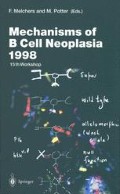Abstract
Cancer dormancy is a phenomenon where neoplastic cells exist within a host without progressive growth (1–3). Clinical examples of dormancy in humans can be found in cases of melanoma (4, 5), breast carcinoma (6), and lymphoma [R. Levy personal communication]. To identify potential mechanisms regulating cancer dormancy, a murine lymphoma model has been established. This dormancy model system utilizes a mouse B-cell lymphoma, BCL1, whose aggressive growth normally leads to rapid splenomegaly, late onset leukemia, and eventual death within 30 days after challenge. However, the development of splenomegaly and subsequent disease can be prevented by immunization of syngeneic recipients with membrane immunoglobulin (mlg) purified from BCL1, prior to challenge. Seventy percent of immunized animals do not develop tumor by 60 days and in some cases can survive up to 2 years, the lifespan of a normal animal. Dormancy established in these animals is not simply the elimination of BCL1 by the host immune system because BCL1, can be specifically detected using polymerase chain reaction and can be isolated using flow cytometry from the spleen of dormant animals. Adoptive transfer of splenocytes from dormant animals to naive recipients results in regrowth of the tumor (7), and is further evidence that BCL1, cells are present.
Access this chapter
Tax calculation will be finalised at checkout
Purchases are for personal use only
Preview
Unable to display preview. Download preview PDF.
References
Hadfield, G. (1954) The dormant cancer cell. Br Med J 2, 607
Wheelock, E. F., Weinhold, K. J., and Levich, J. (1981) The tumor dormant state. Adv Cancer Res 34, 107 – 40.
Yefenof, E., Scheuermann, R. H., ed. (1996) Premalignancy and Tumor Dormancy.Springer-Verlag: Heidelberg, Germany.
Callaway, M. P., and Briggs, J. C. (1989) The incidence of late recurrence (greater than 10 years); an analysis of 536 consecutive cases of cutaneous melanoma. Br J Plast Surg 42 (1), 46 – 9.
Shaw, H. M., Beattie, C. W., McCarthy, W. H., and Milton, G. W. (1985) Late relapse from cutaneous stage I malignant melanoma. Arch Surg 120 (10), 1155 – 9.
Meltzer, A. (1990) Dormancy and breast cancer. J Surg Oncol 43 (3), 181 – 8.
Racila, E., Scheuermann, R. H., Picker, L. J., Yefenof, E., Tucker, T., Chang, W., Marches, R., Street, N. E., Vitetta, E. S., and Uhr, J. W. (1995) Tumor dormancy and cell signaling. II. Antibody as an agonist in inducing dormancy of a B cell lymphoma in SCID mice. J Exp Med 181 (4), 1539 – 50.
Scheuermann, R. H., Racila, E., Tucker, T., Yefenof, E., Street, N. E., Vitetta, E. S., Picker, L. J., and Uhr, J. W. (1994) Lyn tyrosine kinase signals cell cycle arrest but not apoptosis in B-lineage lymphoma cells. Proc Natl Acad Sci U S A 91 (9), 4048 – 52.
Marches, R., Racila, E., Tucker, T. F., Picker, L., Mongini, P., Hsueh, R., Vitetta, E. S., Scheuermann, R. H., and Uhr, J. W. (1995) Tumour dormancy and cell signaling-Ill: Role of hypercrosslinking of IgM and CD40 on the induction of cell cycle arrest and apoptosis in B lymphoma cells. Ther Immunol 2 (3), 125 – 36.
Takata, M., Homma, Y., and Kurosaki, T. (1995) Requirement of phospholipase C-gamma 2 activation in surface immunoglobulin M-induced B cell apoptosis. J Exp Med 182 (4), 907 – 914.
Vitetta, E. S., Tucker, T. F., Racila, E., Huang, Y. W., Marches, R., Lane, N., Scheuermann, R. H., Street, N. E., Watanabe, T., and Uhr, J. W. (1997) Tumor dormancy and cell signaling. V. Regrowth of the BCL1 tumor after dormancy is established. Blood 89 (12), 4425 – 36.
Vitetta, E. S., Thorpe, P. E., and Uhr, J. W. (1993) Immunotoxins: magic bullets or misguided missiles? Trends Pharmacol Sci 14 (5), 148 – 54.
Maloney, D. G., Brown, S., Czerwinski, D. K., Liles, T. M., Hart, S. M., Miller, R. A., and Levy, R. (1992) Monoclonal anti-idiotype antibody therapy of B-cell lymphoma: the addition of a short course of chemotherapy does not interfere with the antitumor effect nor prevent the emergence of idiotype-negative variant cells. Blood 80 (6), 1502 – 10.
Vuist, W. M., Levy, R., and Maloney, D. G. (1994) Lymphoma regression induced by monoclonal anti-idiotypic antibodies correlates with their ability to induce Ig signal transduction and is not prevented by tumor expression of high levels of bcl-2 protein. Blood 83 (4), 899 – 906.
Author information
Authors and Affiliations
Editor information
Editors and Affiliations
Rights and permissions
Copyright information
© 1999 Springer-Verlag Berlin Heidelberg
About this paper
Cite this paper
Hsueh, R.C., Hammill, A.K., Marches, R., Uhr, J.W., Scheuermann, R.H. (1999). Antigen Receptor Signaling Induces Differential Tyrosine Kinase Activation and Population Stability in B-Cell Lymphoma. In: Melchers, F., Potter, M. (eds) Mechanisms of B Cell Neoplasia 1998. Current Topics in Microbiology and Immunology, vol 246. Springer, Berlin, Heidelberg. https://doi.org/10.1007/978-3-642-60162-0_37
Download citation
DOI: https://doi.org/10.1007/978-3-642-60162-0_37
Publisher Name: Springer, Berlin, Heidelberg
Print ISBN: 978-3-642-64283-8
Online ISBN: 978-3-642-60162-0
eBook Packages: Springer Book Archive

